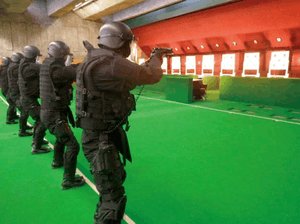Special Investigation Team

The Special Investigation Teams (特殊事件捜査係 Tokushu Jiken Sousa Kakari) are specialized detective units of the Prefectural Police Departments of Japan.[1]
Background
In 1960s, the increase of serious criminal cases such as kidnapping, aircraft hijacking, piracy and bombing became a serious problem in Japan.[1] The kidnapping case of Yoshinobu Murakoshi, a four year old child, raised significant questions to solve these kind of cases. In this case, Hachibē Hiratsuka, a detective assigned to the case, was able to apprehend the suspect, but it was too late to save the victim.[2]
It became clear that traditional criminal investigation systems were sluggish and outdated for these new-style, rapid-tempo, and sometimes lethal cases. As a response to these problems, the Tokyo Metropolitan Police Department (TMPD) established the SIT unit within their Criminal Investigation Bureau in 1964. These detectives were well acquainted with new technology and special tactics to track and capture the criminals quickly and accurately.[2]
At the beginning, the name "SIT" came from an acronym of its romanized Japanese unit name, Special team of the First Investigation Division (捜査一課特殊班 Sousa Ikka Tokushu-han). But later, as its expansion to a section, Sousa Ikka Tokushuhan-Sousa-Kakari (捜査一課特殊犯捜査係), the origin of its name as an acronym of its English name, Special Investigation Team, was added afterwards.[2]
This idea achieved a great success that in 1970, the National Police Agency (NPA) requested the establishment of these kind of units for other Prefectural Police forces throughout Japan.[1] These detectives also became responsible for intervening and rescuing when hostages were in danger. In 1992, TMPD strengthened the SWAT capability by incorporating several SAT members into its SIT.[3]
Organizations
All unit are established in the First Investigation Divisions of each Prefectural Police Departments.[2] These units are generally local-based, so organizations (including their unit names) and equipment are varied. Among them, the Special Investigations Team (SIT) of the TMPD and the Martial Arts Attack Team (MAAT) of the Osaka Prefectural Police are the front-runner, so in hostage cases in rural areas, the NPA order these units to dispatch advisers to the relevant Prefectural Police.[4] These urban units are platoon-size, but some rural units are only fireteam-size, so in case of SWAT operations, these unit can be reinforced by detectives of Mobile Investigation Units (機動捜査隊 Kidō Sousa-tai), first responders for initial criminal investigations.[2]
For manhunt missions, detectives of these units are well acquainted with many technique and technology such as telephone tapping, stakeout, surveillance, and crisis negotiation.[1] And in order to restrain violent criminals quickly, they also have tactical capabilities. In addition to standard service handguns (.38 Special caliber revolvers such as New Nambu M60, or .32 ACP caliber semi-automatic pistols such as SIG Sauer P230), some units are equipped with large 9×19mm Parabellum caliber semi-automatic pistols (Beretta 92 Vertec, for example) and submachine guns (Heckler & Koch MP5 or MP5K PDW).[2] They also use non-lethal weapons such as FN 303 or BGL-65.[5]
Counter-terrorism operations are the affairs of the operators of the Security Divisions, such as Special Assault Teams (SAT) or Anti-firearms squads, so these SWAT-capable detectives are mandated for critical incidents except terrorism.[2] However, in some rural but well-versed Prefectural Police like Aomori, these detectives can form a counter-terrorism task force together with uniformed officers and riot specialists.[6]
- List of special law enforcement units of Criminal Investigation Divisions of Prefectural Police Departments[5]
- Special Investigation Team - Akita, Iwate, Ibaraki, Miyagi, Fukushima, Tochigi, Shizuoka, Aichi, Mie, Fukuoka, Nagasaki, and Tokyo
- Martial Arts Attack Team - Osaka
- Assault Response Team - Chiba
- Special Tactical Section - Saitama
- Special Investigation Section - Kanagawa
- Technical Special Team - Aomori
- Hostage Rescue Team - Hiroshima
Notes
- 1 2 3 4 National Police Agency 1977, p. 769.
- 1 2 3 4 5 6 7 Kakitani & Kikuchi 2008, pp. 18-26.
- ↑ Itō 2004, pp. 193-198.
- ↑ National Police Agency Deputy Commissioner General (March 19, 1998). "Guidelines of Police Policy in Japan" (PDF) (in English language). Retrieved October 18, 2016.
- 1 2 Strike And Tactical Magazine 2017, pp. 46-51.
- ↑ Masashi Otuka (January 2009). "First public exhibition of the TST". Strike And Tactical Magazine (in Japanese language). KAMADO. 6 (1): 10–11.
References
- Itō, Kōichi (2004). The truth of the Metropolitan Police Special unit (in Japanese language). Dainihon-kaiga. ISBN 978-4499228657.
- Kakitani, Tetsuya; Kikuchi, Masayuki (2008). Japanese counter-terrorism units (in Japanese language). Sanshusha Co.,Ltd. ISBN 978-4384042252.
- National Police Agency, ed. (1977). Japan post-war police history (in Japanese language). Japan Police Support Association. NCID BA59637079.
- Strike And Tactical Magazine, ed. (2017). Special forces of Japan (in Japanese language). KAMADO. NCID BB01834038.
See also
- Research and Intervention Brigade - Similar units of the French National Police